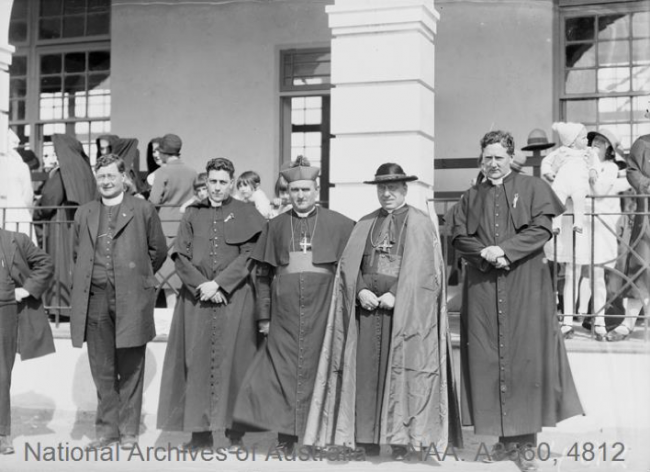Looking back to the Plenary Council of 1937

Bishop John Barry (centre of group wearing biretta) PHOTO: National Archives of Australia, A3560, 4812
The first formal session of the Australian Church’s Fifth Plenary Council is set to go ahead in early October.
Most people are surprised to hear that there have been four previous councils, but the most recent was held in 1937, probably well before any of the current participants were born!
Several articles by Australian writers on this Fourth Plenary Council, held more than 80 years ago, are available online including:
- Nick Brodie ‘A help for the world: the 1937 Plenary Council’ Eureka Street Volume 28, Number 18, September 2018.
- Peter Wilkinson ‘Fourth Plenary Council of Australia and New Zealand, 4-12 September 1937, Parts 1 & 2’ The Swag Autumn and Winter issues, 2020.
For those wanting a summarised understanding of the Fourth Plenary Council these frequently asked questions (and answers) may be of interest.
They suggest the Fifth Plenary Council in its planning, aims and conduct is very different to its immediate predecessor.
Why was the Fourth Plenary Council called?
The Plenary Council was called at the urging of the Apostolic Nuncio, Archbishop Giovanni Panico. A landmark achievement for the Church was the issue of the Code of Canon Law in 1917, the first time Canon Law had been codified to a single document. The Vatican was concerned that in the wake of this all national churches hold a Plenary Council to bring their own governing decrees into line with the new code, and this had been the subject of discussion from the mid-1920s between the Australian Bishops and Panico’s predecessors, Archbishops Cattaneo and Bernardini. With Panico’s urging the Vatican gave approval in 1936 for the Fourth Plenary Council to meet in September 1937
Where did it meet?
The Fourth Plenary Council met in Sydney on 4-12 September 1937. It was hosted by the Archdiocese of Sydney. Plenary sessions were held at St Mary’s Cathedral and in the Cathedral precinct.
What did it achieve?
The agenda of the Plenary Council set out 685 draft decrees – modelled on the 1917 Canon Law code – for consideration/approval. This was achieved with little discussion, and with only minor amendments proposed.
When the proceedings of the Council were published in 1939, following Vatican endorsement, the approved 685 decrees were included, but this part of the document was written in Latin.
A joint pastoral letter from the Australian Bishops was issued at the Council’s conclusion. It deliberated more closely on matters of direct relevance to Australian Catholics, including the social dislocation of the 1930s Great Depression, ongoing levels of unemployment, the international threat of atheistic communism, and the Bishop’s agreement to establish an Australian Secretariat for Catholic Action.
Who attended the Council?
Attending the Fourth Plenary Council were:
- Archbishop Panico
- The 31 ‘Fathers’ of the Australian and New Zealand Churches, ie the Archbishops and Bishops of the dioceses and heads of related geographical regions
- 53 priests. These included theologians and other advisors to the Bishops, superiors of religious congregations and a small number of observers.
Who attended from our Diocese?
There were three participants from the then Diocese of Goulburn:
- The Bishop of Goulburn, Bishop John Barry
- The Diocesan Chancellor, Father Michael Carey (Fr Carey was also Parish Priest of Bega)
- Father Edward O’Donnell. (Fr O’Donnell was a priest of the Goulburn Diocese, but was a noted scholar and in 1937 was lecturing at St Columba’s Seminary, Springwood).
• Denis Connor is the Archivist for the Archdiocese of Canberra and Goulburn


